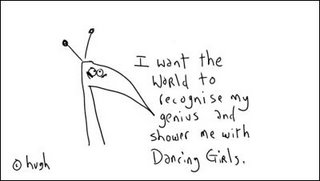Presence calls out attention
Every new piece of information put on the web becomes available to millions, almost instantaneously. Drawing a parallel with material goods, information production can be virtually infinite, and consequently, be in oversupply. Around ten years ago several definitions started appearing for what is now known as the "attention economy". The main concept was that over abundant information could only get value from the attention anyone of us was willing to devote to specific pieces of information.
To get attention you must emit what is technically identifiable as information; likewise for information to be of any value, it must receive attention. Therefore an information technology is also an attention technology, or in other words, a transfer of information is only completed when there is also a transfer of attention proceeding in the opposite direction.
In economy, property is the ownership of wealth. If attention has become a new kind of wealth, then one gain property whenever one attracts and holds it. One attracts attention by making oneself, and whatever one wants attention for, as visible as possible. Thus one holds best onto this form of property by being most open. In fact, this property is in the minds of one's beholders, and there needs to be as many minds as possible.
If one is good enough at attracting attention, it may create a temporary "enslavement", where those giving attention turn over control of a large part of their mind and even body. Attracting attention also means acquiring recognition, identity, and meaning in the eyes of those around. One's store of attention can sustain spirit, mind and body, in just about any form.  At the same time, those paying attention will also want to get attention for themselves by quoting, citing, criticizing, parodying, gossiping about, or referring to an attention grabber as if a star. In the extreme case which govern fans relationships to their stars, giving attention will take multiple forms such as listening to them, heeding what they say, doing what they ask, waiting on them, waiting for them, serving them, loving them, in short doing anything and everything for them.
At the same time, those paying attention will also want to get attention for themselves by quoting, citing, criticizing, parodying, gossiping about, or referring to an attention grabber as if a star. In the extreme case which govern fans relationships to their stars, giving attention will take multiple forms such as listening to them, heeding what they say, doing what they ask, waiting on them, waiting for them, serving them, loving them, in short doing anything and everything for them.
In an "attention economy" it becomes possible to benefit from revealing as much as possible about oneself, including weaknesses, and just about anything else. That way, humanizing oneself not only stir up interest, but makes it easier for others to imagine themselves in one's shoes, which means turning their minds to see from one's eyes, a key part of any "paying of attention". Conversely, hiding away will likely turn attention elsewhere and create a risk of losing at least some of one's attention capital.
When they are not in the same place, peoples maintain presence and proximity through communication. Not through images, or appearance, but by maintaining communication. Beyond this, I think that presence technologies influence and enhance our proximity to one another.
Presence occurs when part or all of an individual's experience is mediated not only by the human senses and perceptual processes but also by human-made technology (i.e., "second order" mediated experience) while the person perceives the experience as if it is only mediated by human senses and perceptual processes (i.e., "first order mediated experience).
Early conceptions limited presence to its spatial and physical context, partly because of the technical nature of the mediation. But timing, rhythm, speed, and continuity, despite having a temporal quality that is easily disrupted by technical mediation, are critical to human communication and social interaction. They are more difficult for us to model and render, but nonetheless, I believe that temporal distortions participate fundamentally in one's sense of being on the same page, being in synch, having or sharing time together.
As a consequence, proximity should not only be based on spatial co-presence anymore, but instead tuned to the frequencies of virtual presence. Proximity in the age of its technical production becomes temporal. Proximity mediated through presence technologies produces continuity in spite of physical separation from one another.
In the "social" web, one trades physical presence for virtual presence negotiation in order to get access to people, obtaining their attention, knowing whether a person is there, and there for oneself. Presence technologies provide a temporal continuity through discontinuous participation, creating a sense of being with others who aren't there by projections of oneself in the virtual world. By doing so, presence technologies have the capacity to bring connectedness to people. They help spanning time and weaving a social fabric whose consistency simulate a "being there" for one another in time, but not space.
The real promise of the "social" web is to help satisfy the ever more pressing desire for attention. It's not the associated communication technologies which are important, but rather the individual and social practices into which the technology becomes embedded: messaging, talking, trading, dating, buying, selling, etc… They all participate into how one is perceived as present in the "virtual world". And when everything else has become boring, only "social" presence remains. In this world, I see presence as a social involvement, one that calls out attention, or to put it another way, in the "social" web it is presence that drives the way people trade attention.
In spite of this simple economical equation, none of the so called "social" networks have yet embarked on a re-architecture based on real-time presence technologies; instead they keep using overhauled legacy web techniques.
Technorati Tags: Presence, Social network, AntecipateLabels: Presence, Social network





<< Home